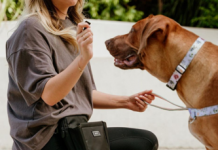When it comes to walking the dog, sometimes it feels more like the dog is walking you! Dogs have noses that get them riled up easily, and they’re quick to track any delightful scent they detect on a walk, even if it is at the expense of their owner. Big dogs especially can be tricky to handle, so it helps to really know the best way to dog walk on a leash.
Start with a great leash:
There’s no one great leash to promote here. Rather, the best way to find the perfect leash for your pup is to look at his or her size, as well as their typical behavior, and to buy a quality one that suits their needs. For example, medium-sized dogs do well with a body harness that’s attached to a leash, as they are controlled easily by their owners with minimal effort with this set up.
Whatever you do, steer clear of the old fashioned leashes that are merely attached to collars, unless your dog is older and not interested in chasing animals, cars or people. These leashes do little to correct behavior, are easy to slip on and off with a change in the dog’s direction, and can be hazardous physically to your dog’s health, not to mention your back as you tug.
Establish your dominance and walk accordingly:
Early on, you’ll need to establish dominance with your dog. Chances are, you’re already doing this by exercising discipline in the home on a regular basis and by teaching commands, but be sure to reinforce this before every walk. You’ll want to do this by making your dog sit or stand still while you attach the leash, and then stay there until you tell him otherwise. The best way to walk the dog is by his side, holding the end of the leash with one hand, and the middle of the leash with the other, keep your body close to his. This allows your dog to understand that you direct the movements, and though he is walking freely with the slack you’ve given the leash with one hand, a quick tug will eliminate the slack and get him right back on track.
Utilize commands when necessary:
Obviously, if your dog understands certain commands in the home, use them outside as needed. Sometimes it helps to utilize a distinct “Tsst” sound when you’d like to correct behavior. The benefit of utilizing this sound outdoors is that it’s effective and draws minimal attention from people or other animals.
Learn what works for your dog as far as leashes go, establish dominance in your walks and use commands as necessary to properly walk your dog in the safest way possible.











